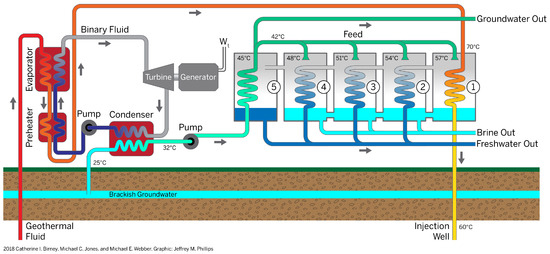A Spatially Resolved Thermodynamic Assessment of Geothermal Powered Multi-Effect Brackish Water Distillation in Texas (MDPI )
by Catherine I. Birney, Michael C. Jones and Michael E. Webber, University of Texas at Austin
Brackish groundwater desalination is increasingly being considered as a means to supplement drinking water in regions facing scarce freshwater supplies. Desalination is more energy intensive and expensive than traditional freshwater sources. One method of offsetting carbon emissions is to pair desalination technology with renewable energy sources.
This research assesses the geographical feasibility of using a geothermal multi-effect distillation (MED) plant to produce freshwater from brackish aquifers in Texas. The system is analyzed using a thermodynamic model of a binary cycle MED plant. The thermodynamic model is integrated with spatially resolved information of Texas’ geothermal gradient and existing brackish well data (such as depth, salinity, and temperature) to quantify production potential.
The results from this study allow for a comparison of potential geothermal desalination plant implementation across all of Texas, rather than a single site assessment. Although this water treatment approach is technologically viable across much of Texas, the system proves to be very energy intensive in all areas except for two hot geopressured fairways in Southeast Texas, the Frio and the Wilcox. In both locations, our research concludes the binary cycle-MED plant can operate self-sufficiently, producing both freshwater and electricity. One well in the fairways can produce 121–1132 m3 of water per day, enough for 232–2133 people.
The framework outlined in this paper can be useful to policymakers and water planners considering where to build desalination facilities.
Read More.........
Spatially Resolved Thermodynamic Assessment of Geothermal Powered Multi-Effect Brackish Water Distillation in Texas, by by Catherine I. Birney, Michael C. Jones and Michael E. Webber, University of Texas at Austin. Resources 2019, 8(2), 65; doi:10.3390/resources8020065
